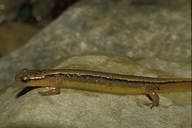|
Eurycea bislineata (Green, 1818)
Northern Two-lined Salamander Subgenus: Manculus | family: Plethodontidae subfamily: Hemidactyliinae genus: Eurycea |
 © 2004 Henk Wallays (1 of 32) |
|
|
|
Description The sides of the female head are almost parallel back of the eyes, converging to a bluntly rounded snout. The male head widens back of the eyes with a snout somewhat swollen in the area of the nasolabial grooves and sometimes small blunt cirri below the nostrils. The long diameter of the eyes is about equal to the length of the snout. Small, oval tongue with a central pedicel. Irregular line of vomerine teeth and parasphenoid teeth in elongate separate patches (Bishop 1943; Petranka 1998). Breeding males have unicuspid and elongated teeth relative to bicuspid teeth of females. Male has premaxillary teeth that often pierces male's lip. Unicuspid teeth replaced with typical bicuspid teeth when breeding season ends (Petranka 1998). Distribution and Habitat Country distribution from AmphibiaWeb's database: Canada, United States U.S. state distribution from AmphibiaWeb's database: Connecticut, District of Columbia, Delaware, Massachusetts, Maryland, Maine, New Hampshire, New Jersey, New York, Ohio, Pennsylvania, Rhode Island, Virginia, Vermont, West Virginia Canadian province distribution from AmphibiaWeb's database: New Brunswick, Newfoundland and Labrador, Ontario, Quebec
Life History, Abundance, Activity, and Special Behaviors Eggs: Females lay unpigmented or white to pale yellow eggs with a diameter of 2.5-3 mm. Clutch size positively correlates with size of female. Two envelopes surround the eggs; the outer one is drawn out to form an attachment disk (Bishop 1943). Sometimes in the same place as others, a female attaches eggs singly to lower surface of a support in running, but rarely stagnant water. Ovipositional sites usually attended by at least one adult through hatching. Incubation period is about 4-10 weeks, depending on temperature of water (Petranka 1998). Defense: Adults will actively defend home shelters by aggressive posturing or biting. Predators include owls, snakes, and fish. Most E. bislineata become immobile when contacted by snakes but will engage in protean flipping and flight when contacted by the snake's tongue. The decision to stay or flee depends on the individual's physical abilities. Can also autotomize the tail when attacked by snakes (Petranka 1998). Larva In a terrestrial environment, they live along stream margins and surrounding forests, making seasonal migrations to and from breeding streams. Juveniles and adults both feed on prey such as wood roaches, spiders, ticks, earthworms, isopods, millipedes, beetles, snails, and flies (Petranka 1998). Hatchlings and older larvae are dusky colored with six to nine pairs of light dorsolateral spots on body. Streamlined body with tail fin stopping near insertion of rear limbs. Usually light-colored venter with many iridophores. Large larvae from extreme northern parts of the range sometimes have dark colored throats and bellies (Petranka 1998). Trends and Threats Comments The salamander fungus Batrachochytrium salamandrivorans (Bsal) is spreading in Europe and has the potential to invade North America. Gray et al. (2023) investigated how susceptible North American salamanders, newts, and sirens are to Bsal. They also infected some native and invasive species of frogs. The researchers found that a large portion (74%) of the species they tested could be infected, and over a third (35%) died from the infection, which included both salamanders and frogs. Newts (Salamandridae) and lungless salamanders (Plethodontidae) were among the most vulnerable salamander families, confirming earlier findings (Martel et al. 2014). The findings suggest that Bsal could cause significant salamander die-offs, particularly in the Appalachian region and along the West Coast of the United States. Larval stages (e.g., Eurycea bislineata) were infected as well. Sadly, the study predicts that over 80 salamander species in the US and 140 in all of North America could be lost due to Bsal. Of great concern, Bsal infected two species that frequently occur in the pet trade in the experiments, suggesting these species could be reservoirs of Bsal or could bring Bsal when imported from countries were Bsal occurs; one of them (Osteopilus septentrionalis) is invasive in Florida and has spread to South Carolina, further increasing the threat of disease spread should Bsal arrive to the US. (Written by Ale Catenazzi)
References
Bishop, S.C. (1943). Handbook of Salamanders. Comstock Publishing Company, Inc., Ithaca, New York. Petranka, J. W. (1998). Salamanders of the United States and Canada. Smithsonian Institution Press, Washington D.C. and London. Originally submitted by: Chih Wang (first posted 2001-05-07) Edited by: Tate Tunstall, Kevin Gin (12/03), Michelle S. Koo (2024-04-21) Species Account Citation: AmphibiaWeb 2024 Eurycea bislineata: Northern Two-lined Salamander <https://amphibiaweb.org/species/4049> University of California, Berkeley, CA, USA. Accessed May 25, 2025.
Feedback or comments about this page.
Citation: AmphibiaWeb. 2025. <https://amphibiaweb.org> University of California, Berkeley, CA, USA. Accessed 25 May 2025. AmphibiaWeb's policy on data use. |




 Raffaëlli Account
Raffaëlli Account Map of Life
Map of Life